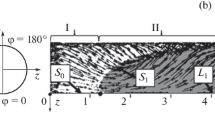Abstract
Three-dimensional compressible gas flow past an arbitrary model body at large angles of attack is analyzed in the framework of the boundary layer theory with allowance for heat transfer. The equations of a three-dimensional turbulent boundary layer are solved using computer codes, the data on the external inviscid flow, and the body geometry.
Similar content being viewed by others
References
K. K. Fedyaevskii, A. S. Ginevskii, and A. V. Kolesnikov.Calculation of a Turbulent Incompressible Boundary Layer [in Russian], Sudostroenie, Leningrad (1973).
V. A. Aleksin and Yu. D. Shevelev, “Numerical analysis of three-dimensional turbulent boundary layers. Method of calculation,” Preprint No. 147 [in Russian], Institute of Problems of Mechanics, USSR Academy of Sciences, Moscow (1980).
Yu. Kh. Rotta, “A family of models of turbulence for three-dimensional boundary layers,” in:Turbulent Shear Flows, Vol. 1 [in Russian], Mashinostroenie, Moscow, 279 (1982).
V. A. Aleksin and Yu. D. Shevelev, “Three-dimensional turbulent boundary layer on an arbitrary body,”Izv. AN SSSR, Mekh. Zhidk. Gaza, No. 5, 25 (1986).
V. A. Aleksin and S. N. Kazeikin, “Heat transfer in a three-dimensional boundary layer on an arbitrary body at large angles of attack,” in:Gagarin Scientific Readings in Cosmonautics and Aviation [in Russian], Nauka, Moscow, 121 (1988).
F. H. Hirshel and W. Kordulla, “Shear flow in surface-oriented coordinates,” in:Notes on Numerical Fluid Mechanics, Vol. 4, Vieweg und Sohn Braunschweig, Wiesbaden (1981–1986).
K. O. Wang, “On the determination of the zones of influence and dependence for three-dimensional boundary layer equations,”J. Fluid Mech., Vol. 48, Pt. 2, 387 (1971).
P. Bradshaw, “Calculation of three-dimensional turbulent boundary layers,”J. Fluid Mech., Vol. 46, Pt. 3, 417 (1971).
P. L. Maksin, B. S. Petukhov, and A. F. Polyakov, “Calculation of turbulent heat transfer in stabilized flows in tubes,” in:Heat-Mass Transfer-V, Vol. 1 [in Russian], Minsk, 14 (1976).
I. V. Petukhov, “Numerical calculation of two-dimensional flows in a boundary layer,” in:Numerical Methods for Solving Differential and Integral Equations and Quadrature Formulas [in Russian], Nauka, Moscow, 304 (1964).
H. H. Fernholz and E. Krause, eds.,Three-Dimensional Turbulent Boundary Layer, IUTAM Symp., 1982, Springer, Berlin (1982).
W. Kordulla, “Investigations related to the inviscid-viscous interaction in transonic flows about finite 3D wings,” AIAA Pap., No. 77-209 (1977).
I. Cebeci, A. K. Khattab, and K. Stewartson, “Three-dimensional laminar boundary layers and the OK of accessibility,”J. Fluid Mech., Vol. 107, 57 (1981).
J. P. F. Lindhout, A. C. De Bruid, and J. M. Gooden, “A method for three-dimensional boundary layer calculations on arbitrary bodies,” in:Three-Dimensional Turbulent Boundary Layers, Springer, Berlin, 298 (1982).
S. N. Kazeikin, E. V. Semushkina, and Yu. D. Shevelev, “On some methods for calculating and visualizing the geometry of a complicated shape,” Preprint No. 286, [in Russian], Institute of Problems of Mechanics, USSR Academy of Sciences, Moscow (1987).
N. V. Pogorelov and Yu. D. Shevelev, “Numerical analysis of supersonic flow past the front portion of blunt bodies at large angles of attack,” Preprint No. 175, [in Russian], Institute of Problems of Mechanics, USSR Academy of Sciences, Moscow (1981).
V. S. Avduevskii, “Effect of the curvature of a shock wave on heat transfer in three-dimensional supersonic flows past bodies,” in:Investigation of Heat Transfer in Gas and Liquid Flows [in Russian], Mashinostroenie, Moscow, 29 (1965).
Yu. G. El'kin, Yu. N. Ermak, I. I. Lipatov, and V. Ya. Neiland, “Absorption of the entropy layer on a blunted cone in hypersonic viscous gas flow,”Uch. Zap. TsAGI,12, No. 1, 101 (1983).
V. A. Borovoi, R. Z. Davlet-Kil'deev, and M. V. Ryzhkova, “On the specifics of heat transfer on the surface of some lifting bodies at high supersonic velocities,”Izv. AN SSSR, Mekh. Zhidk. Gaza, No. 1, 101 (1968).
Author information
Authors and Affiliations
Additional information
Translated from Izvestiya Rossiiskoi Akademii Nauk, Mekhanika Zhidkosti i Gaza, No. 3, pp. 55–66, May–June, 1995.
Rights and permissions
About this article
Cite this article
Aleksin, V.A. Analysis of the three-dimensional turbulent boundary layer on the suface of an arbitrary body at large angles of attack. Fluid Dyn 30, 378–386 (1995). https://doi.org/10.1007/BF02282450
Received:
Issue Date:
DOI: https://doi.org/10.1007/BF02282450




